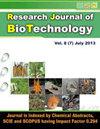曼陀罗(Datura stramonium L.)叶、花和大麻(Cannabis sativa L.)种子对某些蚊子幼虫(双翅目:蝇科)的杀生能力
IF 0.2
Q4 BIOTECHNOLOGY & APPLIED MICROBIOLOGY
引用次数: 0
摘要
以植物为基础的替代杀虫剂安全、有效、环保,可用于替代合成杀虫剂。本研究旨在评估曼陀罗叶(DL)和花(DF)以及大麻籽(CS)对阿拉伯按蚊、库蚊和埃及伊蚊幼虫的杀生能力。所选植物部分取自大学花园的实验农场。阿拉伯伊蚊幼虫对每种植物乙醇提取物的半数致死浓度(LC50s)被用来估算存活和畸形试验的单一诊断剂量。对所选植物部分进行了气相色谱-质谱分析。结果显示,DL 乙醇提取物中检测到 14 种化合物,其中丁醇、3-甲基是主要成分(79.76%),其次是甲苯(6.14%)。还检测到植物醇(3.9%)。从 DF 中检测到 14 种化合物,其中甲酸 3-甲基丁-2-基酯是主要成分(82.22%),其次是十二酸乙酯(3.3%)和甲苯(2.86%)。此外,在 CS 中,屈大麻酚(41.4%)是主要成分,其次是大麻酚(10.38%)、植物醇(10.38%)和卡里芬(2.07%)。对阿拉伯蚂蚁幼虫的药敏试验显示,DL 的半致死浓度为 562.95 毫克/升,DF 为 424.41 毫克/升,CS 为 175.40 毫克/升。结果表明,3-6%的阿拉伯伊蚊、1-28%的库蚊和 12-22% 的埃及伊蚊幼虫在一周后发育成蛹,其中一些发育成成虫。在存活率测试中,超过 70% 的幼虫被浓度为 50% 或更低的杀虫剂杀死。在按蚊、库蚊和伊蚊幼虫身上监测到了一些畸形现象,包括身体膨胀、消化管分离。应进行实地评估,并重新编写半数致死浓度的概念。本文章由计算机程序翻译,如有差异,请以英文原文为准。
The Biocidal capacity of Datura (Datura stramonium L.) leaves and flowers and Cannabis (Cannabis sativa L.) seeds on some Mosquito’s larvae (Diptera: Culicidae)
Plant-based alternative pesticides are safe, effective, eco-friendly and can be used instead of synthetic pesticides. The aim of this study was to evaluate the biocidal capacity of Datura stramonium leaves (DL) and flowers (DF) and Cannabis sativa seeds (CS) on Anopheles arabiensis, Culex quiquefasciatus and Aedes aegypti larvae. The selected plant parts were collected from the experimental farm, the University garden. The LC50s of A. arabinoses larvae towards the ethanol extract of each plant part were taken to estimate the single diagnostic dose for the survival and deformities tests. GC-MS analysis for the selected plant parts was investigated. The results show that DL ethanol extract detected 14 compounds of which butanol,3-methyl is the main component (79.76%) followed by toluene (6.14%). Phytol was also detected (3.9%). 14 compounds were detected from DF of which formic acid,3-methylbut-2-yl ester was the main component (82.22%) followed by dodecanoic acid, ethyl ester (3.3%) and toluene (2.86%). Also, from CS, Dronabinol (41.4%) was the main component, followed by Cannabinol (10.38%), Phytol (10.38%) and Caryophylene (2.07%). The susceptibility test of An. arabiensis larvae revealed the LC50’s of 562.95 mg/L for DL, 424.41 mg/L for DF and 175.40 mg/L for CS. It was noticed that 3-6% of An. arabiensis and 1-28% of Culex quiquefasciatus and 12-22% of Aedes aegypti larvae developed to pupae and some of them developed to adult stage after one week. In the survival test, more than 70% of the larvae were killed by a concentration supposed to kill 50% or less of the larvae. Some deformations were monitored on Anopheles, Culex and Aedes larvae including swelled body, separated alimentary canal. Field assessment should be run and the concept of LC50 should be re-written.
求助全文
通过发布文献求助,成功后即可免费获取论文全文。
去求助
来源期刊

Research Journal of Biotechnology
BIOTECHNOLOGY & APPLIED MICROBIOLOGY-
CiteScore
0.60
自引率
0.00%
发文量
192
期刊介绍:
We invite you to contribute Research Papers / Short Communications / Review Papers:
-In any field of Biotechnology, Biochemistry, Microbiology and Industrial Microbiology, Soil Technology, Agriculture Biotechnology.
-in any field related to Food Biotechnology, Nutrition Biotechnology, Genetic Engineering and Commercial Biotechnology.
-in any field of Biotechnology related to Drugs and Pharmaceutical products for human beings, animals and plants.
-in any field related to Environmental Biotechnolgy, Waste Treatment of Liquids, Soilds and Gases; Sustainability.
-in inter-realted field of Chemical Sciences, Biological Sciences, Environmental Sciences and Life Sciences.
-in any field related to Biotechnological Engineering, Industrial Biotechnology and Instrumentation.
-in any field related to Nano-technology.
-in any field related to Plant Biotechnology.
 求助内容:
求助内容: 应助结果提醒方式:
应助结果提醒方式:


